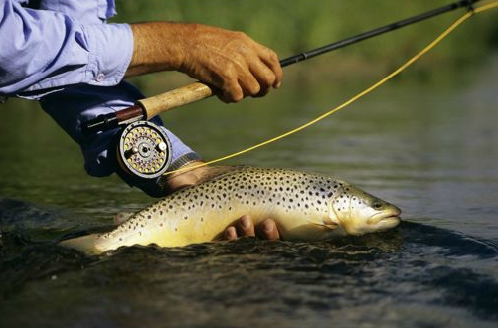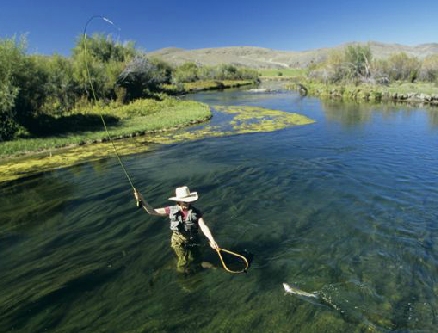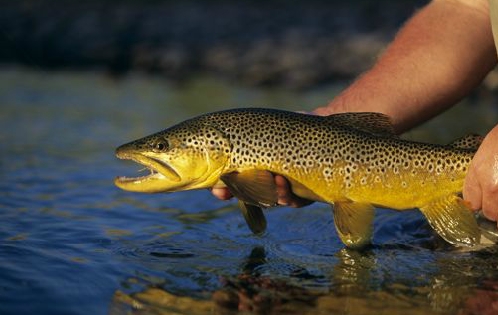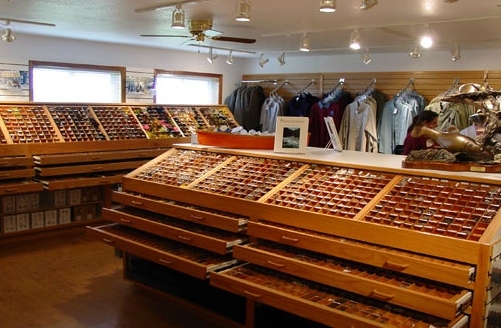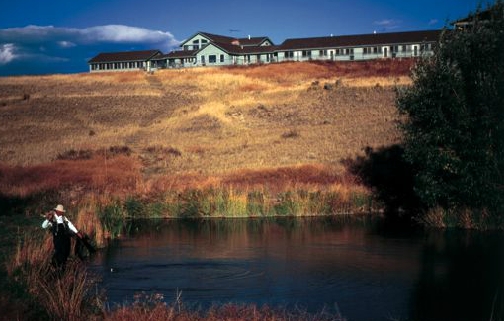Destination Overview
Accommodations and Lodging
Each large guest room has comfortable, king or two queen beds, a private bath, beautiful views of the surrounding mountains, and a door leading to decks and garden areas. Relax and enjoy sunrises, spectacular Montana sunsets, and clear star-filled nights.
Dining
Dining is a sublime experience at Five Rivers Lodge. Delicious hors d’oeuvres are served each evening before dinner in a room adjacent to the Dining Room. Our culinary trained and experienced chefs want our cuisine to include your choices. We work with individuals’ needs and preferences to prepare healthy gourmet meals. Let us know what’s best for you. It’s easy for us to prepare meals that are no fat, no cholesterol, no salt, vegetarian for some guests and meals for others guests who prefer all the sauces, lots of red meat and rich desserts. Or anything in between…
Please inform us of any dietary restrictions in advance, before departure.
Fishing Information
Montana’s prime streams are just 30 minutes away from the lodge in one direction or another. The names are legendary for the big trout they hold: the Beaverhead (upper and lower section), the Big Hole, Ruby, Jefferson, Madison, and a number of smaller but very productive creeks and ponds.
Beaverhead River
The 69-mile-long journey of the Beaverhead River begins at the outlet of the Clark Canyon Reservoir, an irrigation storage facility built in 1964. The Beaverhead river is divided into two distinct sections with unique fishing conditions, and it joins the Big Hole River at Twin Bridges, Montana to form the Jefferson River.
The upper portion of the Beaverhead, stretching about 12 miles from the Clark Canyon Reservoir to the Barretts Diversion Dam, is the most fished section. The outflow from the reservoir pumps cold water into the Beaverhead river, making it the coldest section of the river and provides excellent habitat for large rainbows and brown trout. According to one count, there are approximately 3800 fish per mile here, and a fish of four pounds or better every 20 feet of bank. Overhanging willows and cottonwoods line the banks of this fast-flowing stretch, and wading can be very difficult because of the brushy banks and steep cliffs. Yet while casting to the banks can be tricky, floating the Beaverhead river is by far the easiest and most productive way to fish this section.
Below Barretts Dam, the Beaverhead River flows into the valley where irrigation plays a major role. While the dam diverts nearly half of the river water, private lands use much of the remaining flow for irrigation. Therefore, the Beaverhead River from Barretts Dam to Dillon is slower and warmer than the upper section. In addition, the river here may not be floated in late summer during lowwater . While wade fishing is much easier here, accessing the river can be difficult because it flows primarily through private lands.The stretch of water from Dillon downstream to the confluence with the Ruby river holds substantially larger fish. The Beaverhead usually gets quite warm as it runs slowly out in the middle of the valley. For anglers looking for a more secluded walk-wade or float, our guides at Five Rivers Lodge have the knowledge and access to many of the best fishing on this lower Beaverhead river where access is almost nonexistent beacause of private farmland.
Big Hole River
Free flowing its entire course, the Big Hole river extends 153 miles from its modest beginnings at Skinner Lake in the Beaverhead Mountains of southwest Montana to its confluence with the Beaverhead River near Twin Bridges. Early explorers and settlers came to the Big Hole and to the high elevation valley that it divides for the sheer beauty and rich resources it provided. Since then, it has been designated at a “Blue Ribbon” fishery and is one of the most heavily used fishing streams in Montana.
The Upper Big Hole is home to the last stream-dwelling population of Arctic grayling in the lower 48 states. This has prompted many significant private partnerships and cooperative efforts to ensure the protection of this valuable population.
The Big Hole’s mid-June emergence of the famous “Salmonfly Hatch” kicks off the fishing season. The chance to throw two-inch -long dry flies for trout averaging eighteen inches is a rare treat that many anglers anticipate. That said, mid-June is also the most heavily fished time on the Big Hole river.
Dry fly fishing for rainbows and browns continues to the end of July, with prolific hatches of caddis, mayflies and lesser stoneflies.
During August the Big Hole river becomes primarily a morning and evening fishery, although occasionally the summer hopper and ant hatches can provide excellent mid-day action as well. Tricos blanket the river in the mornings, while the evening can provide tremendous caddis hatches.
The first freeze of autumn occurs in early September, cooling the waters and thus resuming the possibility of daylong fishing. At this time, the big browns prepare for spawning, their color matching the golden-turning cottonwood trees along the river’s banks. Then in October, the Big Holer river provides excellent foot fishing using streamers and nymphs in the mornings and caddis and Red Quill imitations during the warmer Indian summer afternoons.
Ruby River
The Ruby River begins in the Gravelly Range of southwest Montana and flows into Ruby Reservoir. Below the reservoir, it flows into a valley that lies between the Ruby Range to the south and the Tobacco Root mountains to the north. The river ends at the confluence of the Jefferson River at Twin Bridges, Montana.
Compared to the other rivers, the Ruby River has the most difficult access for a few reasons: it primarily flows through private lands, the narrow and meandering waters are lined with extremely dense brush, only a few roads cross the river, and it is located in a remote part of the state.
The upper stretch, above the Ruby Reservoir, runs clear and through the pristine and mountainous backdrop. It has excellent flyfishing for rainbows, grayling and cutthroats. Narrow and winding, this section passes through national forest lands where access is best.
Once the Ruby river leaves the national forest lands, access becomes very difficult. Be prepared to fish and wade in the river, not along the riverbanks, as many landowners have erected tall fences right up to the bridge accesses and along the dense brushy banks.
Below the Ruby Dam, one will find prime brown trout waters. And while access is a little easier than the stretch above the dam, thick brush again lines the banks making flyfishing from the shore nearly impossible.
Due to extensive irrigation withdrawals, the Ruby River looses much of its water as it travels downstream from the dam. Further down from the dam, it more resembles a spring creek, requiring care as to avoid spooking the fish. Considered to be one of the state’s prime grasshopper fishing waters, the Ruby’s hopper fishing on this lower stretch goes from late June through the first frost of the year.
Jefferson River
The Jefferson River begins near Twin Bridges with the confluence of the Beaverhead, Big Hole and Ruby rivers. It flows more than 80 miles to its confluence with the Missouri River at Missouri River Headwaters State Park.
Unlike its neighboring rivers, the Jefferson River has a very slow current, and irrigation can literally drain the river dry during drought periods. Wade fishing is difficult because it runs slow and deep in many places and steep banks frequently hem the waters. In addition, frequent paddling may be required to get anywhere and several dams exist which may require portaging your boat.
The Jefferson river is divided into three distinct sections. The upper section meanders for 50 miles at a moderately slow pace, passing brushy and undercut banks. This section provides the best fly fishing for brown trout, and large streamers or nymphs prove more successful than trying for any surface action.
In the middle section, the Jefferson River flows through a steep, arid canyon. It has decent fishing access here, with a road paralleling it on one side and railroad tracks on the other.
The lower section, especially on the last 20 miles, the Jefferson River flows through good grasshopper country. Hopper fishing here can often entice large browns right up to the surface.
Madison River
The Madison River originates in Yellowstone National Park at the junction of the Firehole and Gibbon rivers and flows in a northerly direction for 140 miles to Three Forks, Montana, where it joins the Jefferson and Gallatin rivers to form the Missouri River. From its source in the park, the Madison flows across a high conifer-forested plateau, its journey interrupted by two man-made impoundments: Hebgen Reservoir, located one and one-half miles below the park boundary, and Ennis Reservoir, 58 miles downstream from Hebgen.
Just below Hebgen, the Madison feeds Quake Lake, a natural lake formed by an earth slide during a major earthquake in 1959. From Ennis Reservoir the Madison flows through Bear Trap Canyon before entering the lower Madison River valley for its final 18 miles. The Madison is one of Montana’s premier wild trout rivers. Due to its national reputation, heavy fishing pressure, good access, high scenic value, and excellent wild trout populations, it has been classified as a “Blue Ribbon” trout stream.
The Madison is also the home of “wild trout management,” where the results of a controversial study in the early 1970s introduced a shift in management emphasis nationwide, from stocking trout to population monitoring, harvest regulation, and habitat protection. A number of challenges exist to wild trout fisheries in the Madison River, such as whirling disease, increased angling pressure, and drought.
Private Access Waters
You will enjoy fishing over two acres of spring fed ponds with miles of private wading access on spring creeks and rivers. Very large brown trout inhabit the rivers and spring creeks, many 24″ to 26″ long. Anglers regularly hook 8 to 10 fish a day over 20″. It is divided into seven sections and two anglers are allowed to fish each section only once every seven days.
Rates
Based on double occupancy, two anglers per guide
* 2 day/ 3 night $ 1,695.00
* 3 day/ 4 night $ 2,295.00
* 4 day/ 5 night $ 2,895.00
* 5 day/ 6 night $ 3,525.00
* 6 day/ 7 night $ 3,995.00
Single Room Supplement $125 p/n
Single Angler supplement with a guide $240
Rod fees on the private waters are $100 per day
Non-Angler Rate = Lodging rate – half the guided rate
Arrive any day
Remember Fishermen’s Spot Travel services are always FREE to you! You never pay more than what you would pay if you booked directly with the lodge.
What’s Included:
- Three meals per day
- Pre-dinner beverages (no hard alcohol)
- Appetizers
- Transportation to and from Bozeman Airport (BZN)
What’s Not Included:
- Air transportation to and from the local airport
- Montana Fishing License
- Gear and flies
- Gratuities for guides and staff
How to get there
DRIVING
Five Rivers Lodge is located in the South West corner of Montana on Highway 41 between Dillon and Twin Bridges (approximately 100 miles South West of Bozeman)
FLYING
You can fly into Bozeman Airport. The lodge will transfer you to and from the airport.
Non-Angling Activities
Non-fishing guests can choose from a variety of experiences. Browse our extensive library. Take a literary tour of the area. Guided and self-guided tours, explore western history, gardening, photography, literature, and the arts. You can ride horses, or hike. Your day trips include a gourmet lunch. If you’re into photography, catch the best afternoon light.
Virginia City, Montana
Virginia City is a living town of 150 year round residents who host the West’s best preserved gold mining town from the 1860s. It’s located, just 42 minutes, Northeast of Five Rivers Lodge. Nevada City is just a mile west of Virginia City. This is a neat town and fun to photograph.
Other Information
The Five Rivers Lodge Fly Shop
The largest fly selection in the state of Montana or the country for that matter














